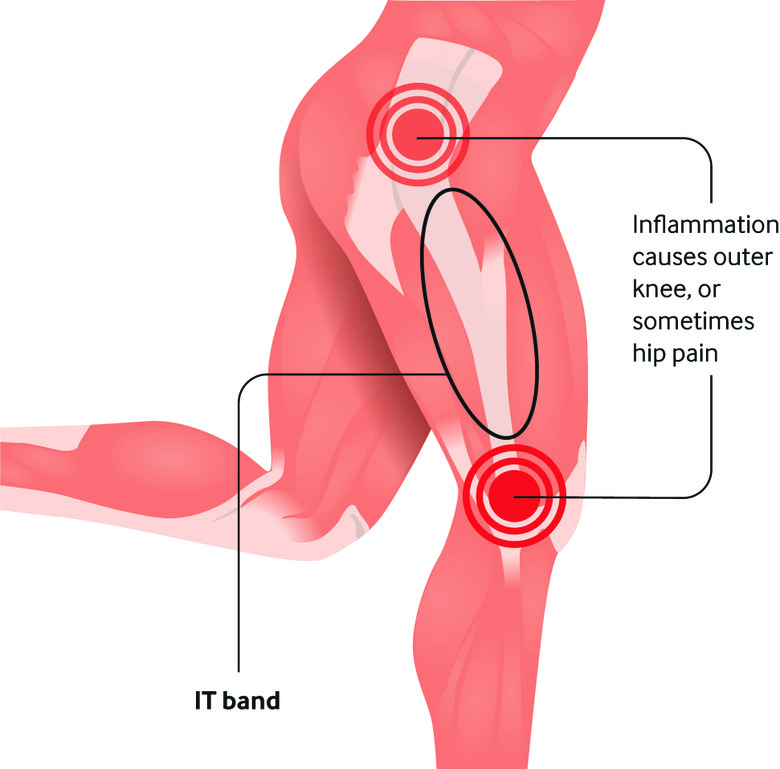Expert IT Band Syndrome Treatment in Vadodara
Find relief from knee and hip pain with professional chiropractic care. Get back to running and active living without drugs or surgery.

Understanding IT Band Syndrome
A common overuse injury affecting runners and active individuals
What is IT Band Syndrome?
Iliotibial Band Syndrome (ITBS) is an overuse injury that causes pain on the outside of the knee, and sometimes the hip, due to inflammation of the iliotibial band. This thick band of connective tissue runs from the hip down the outside of the thigh to the shin bone. Common causes include:
- Repetitive friction of the IT band rubbing against the lateral femoral condyle
- Biomechanical issues like overpronation, leg length discrepancy, or muscle imbalances
- Training errors such as sudden increases in mileage, downhill running, or always running on the same side of the road
- Weak hip abductors leading to poor pelvic stability during activity
- Tightness in surrounding muscles including glutes, TFL, and hamstrings
Chiropractic care addresses the underlying biomechanical issues while reducing inflammation and promoting proper tissue healing.

Recognizing IT Band Syndrome Symptoms
Early identification helps prevent chronic issues and faster recovery
Lateral Knee Pain
Sharp or burning pain on the outside of the knee, typically occurring during activity and easing with rest.
Snapping Sensation
Audible or palpable snapping or popping sensation as the IT band moves over the lateral femoral condyle.
Tenderness & Swelling
Tenderness to touch on the outside of the knee, sometimes accompanied by mild swelling or inflammation.
Pain with Specific Movements
Pain worsens with activities involving knee flexion, such as running downhill, descending stairs, or prolonged sitting.
Common Causes & Risk Factors
Understanding what leads to IT Band Syndrome helps in prevention
Training Errors
Sudden increases in mileage, intensity, or frequency. Running on banked surfaces or always in the same direction.
Biomechanical Issues
Overpronation, leg length discrepancy, hip muscle weakness, or poor running form increasing stress on the IT band.
Muscle Imbalances
Weak gluteus medius, tight TFL and hip flexors, or inadequate core stability leading to compensatory movements.
Equipment Issues
Worn-out shoes, improper footwear, or inadequate recovery equipment contributing to tissue stress.
Our IT Band Syndrome Treatment Approach
Evidence-based chiropractic care for complete recovery and prevention
Comprehensive Assessment

Gait & Running Analysis
Detailed evaluation of running form, foot strike pattern, and biomechanics to identify contributing factors.

Muscle Function Testing
Assessment of hip strength, flexibility imbalances, and functional movement patterns affecting IT band tension.

Structural Alignment
Evaluation of pelvic alignment, leg length, and spinal mechanics that may contribute to IT band issues.
Our Treatment Methods

Soft Tissue Release
Targeted techniques to release tension in the IT band, TFL, glutes, and surrounding musculature.

IASTM Therapy
Instrument-assisted soft tissue mobilization to break down adhesions and improve tissue mobility in the IT band.

Joint Mobilization
Gentle adjustments to restore proper hip, knee, and pelvic alignment, reducing abnormal stress on the IT band.

Dry Needling
Precise needling techniques to release trigger points in tight muscles contributing to IT band tension.

Hip Strengthening
Targeted exercises to strengthen weak hip abductors and improve pelvic stability during activity.

Flexibility Training
Customized stretching program for tight muscles while maintaining optimal IT band tissue health.
Recovery & Return to Activity
Structured approach for safe return to running and sports
Phase 1: Pain Reduction (Weeks 1-2)
Focus: Reduce inflammation and pain
- Relative rest from aggravating activities
- Cross-training with swimming or cycling
- Ice therapy and anti-inflammatory modalities
- Gentle stretching and soft tissue work
Phase 2: Rehabilitation (Weeks 3-6)
Focus: Correct biomechanics and build strength
- Progressive hip and core strengthening
- Gait retraining and running form correction
- Gradual return to running program
- Continued flexibility and mobility work
Phase 3: Return to Sport (Weeks 6-12+)
Focus: Full functional recovery and prevention
- Sport-specific training and drills
- Gradual increase in mileage and intensity
- Maintenance strength program
- Ongoing biomechanical monitoring
Patient Success Story
Real results from our IT Band Syndrome treatment
"As a marathon runner, IT Band Syndrome had sidelined me for months. I tried everything from foam rolling to rest, but the pain always returned when I started running again. Dr. Chandresh's comprehensive approach was completely different. He identified my weak hip muscles and poor running form as the root causes. Through targeted strengthening, gait retraining, and chiropractic adjustments, I was not only pain-free but actually running more efficiently than before. I've since completed two marathons without any IT band issues!"
- Marathon Runner from Vadodara (IT Band Syndrome Recovery)
Preventing IT Band Syndrome
Proactive strategies for long-term running and athletic health
Hip Strengthening
Regular strengthening of gluteus medius and hip abductors to maintain pelvic stability during activity.
Smart Training
Follow the 10% rule for mileage increases, vary running surfaces, and avoid always running on banked roads.
Proper Footwear
Replace running shoes every 300-500 miles and choose shoes appropriate for your foot type and gait.
Regular Mobility Work
Incorporate foam rolling, stretching, and mobility exercises for hips, glutes, and IT band into your routine.
Cross-Training
Include low-impact activities like swimming, cycling, or strength training to maintain fitness while reducing impact.
Professional Guidance
Regular chiropractic check-ups to maintain proper biomechanics and address issues before they become problematic.
Ready to Run Pain-Free Again?
Book your consultation today and start your journey back to pain-free activity
Comprehensive Biomechanical Correction
No drugs, no surgery - just proven chiropractic techniques to address the root causes of IT Band Syndrome